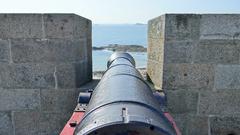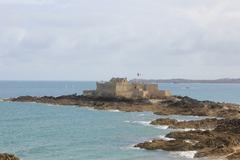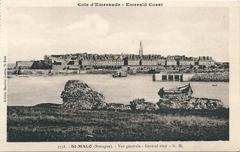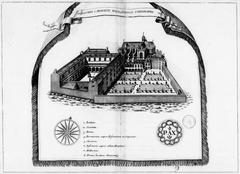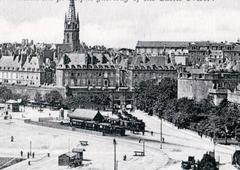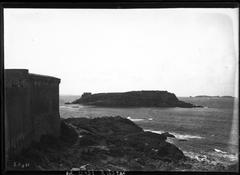Couvent Notre-Dame-Des-Victoires Saint-Malo: Visiting Hours, Tickets, and Comprehensive Travel Guide
Date: 14/06/2025
Introduction
Nestled within the storied ramparts of Saint-Malo, Brittany, the Couvent Notre-Dame-Des-Victoires stands as a distinguished monument to the city’s religious, artistic, and historical heritage. Founded in the early 17th century by the Order of the Visitation of Holy Mary, this convent has witnessed centuries of spiritual devotion, conflict, and transformation. Its austere granite architecture, evocative cloisters, and rare religious artworks—such as the celebrated mural “L’Annonce aux Bergers”—make it a compelling destination for travelers, pilgrims, and history enthusiasts alike.
Today, the Couvent Notre-Dame-Des-Victoires is both a protected historical monument and an important cultural site in Saint-Malo. It offers visitors a unique lens on the city’s layered past, from its days as a monastic sanctuary and educational center, through periods of revolutionary upheaval and war, to its present role as a symbol of resilience and urban continuity. This guide gathers all essential information for planning a visit, including historical context, visiting hours, ticketing, accessibility, and practical travel tips. For further details and updates, refer to the Saint-Malo Tourist Office and the Order of the Visitation.
Table of Contents
- Historical Overview
- Visitor Information
- What to See: Key Features of the Convent
- Nearby Attractions in Saint-Malo
- Frequently Asked Questions (FAQ)
- Visuals and Media Resources
- Summary and Visitor Recommendations
- Sources
Historical Overview
Foundation and Early Significance
The Couvent Notre-Dame-Des-Victoires was founded in the early 17th century by the Visitandine nuns, an order established in Annecy in 1610 by Saint Francis de Sales and Saint Jane Frances de Chantal (Order of the Visitation). The convent’s dedication to Our Lady of Victories reflects both gratitude for divine intervention in times of conflict and the broader Catholic renewal of the Counter-Reformation. Supported by local nobility and clergy, the convent became a center for spiritual life, education, and charity—especially for young women from noble and bourgeois families.
Architectural and Artistic Highlights
Constructed from local granite, the convent’s buildings exemplify the austere elegance of Breton religious architecture. Notable features include:
- Chapel: With a simple façade and a single nave, the chapel was designed for contemplative worship.
- Cloisters: Tranquil spaces for reflection, some arcades of which remain preserved.
- Artworks: The 17th-century mural “L’Annonce aux Bergers” is a rare example of period religious art in Brittany and is protected as a Monument Historique (Mérimée Database).
The convent’s architecture blends late Gothic and early Baroque influences, emphasizing spiritual focus over ornamentation, and its thick walls and modest design echo both monastic values and the city’s defensive heritage (Saint-Malo Heritage).
The Convent Through Revolution and War
The French Revolution dramatically altered the convent’s trajectory: in 1792, the Visitandine nuns were expelled, religious property was confiscated, and the buildings were converted for military and administrative use (French Revolution and Religious Orders). In the 19th century, the former convent became the Caserne des Victoires, a military barracks—a fate shared by many monastic sites in France (Wikipatrimoine).
During the Allied bombings of Saint-Malo in World War II, the convent sustained significant damage, but post-war restoration efforts succeeded in preserving its most valuable architectural and artistic elements (Saint-Malo WWII History).
Restoration and Contemporary Heritage Status
Restoration in the 20th century stabilized the chapel and conserved key features, including the mural. Today, the convent is a protected heritage site, with portions recognized as a Monument Historique since 1929 and the mural since 1962 (communes.com). While no longer an active convent, the site is occasionally used for special liturgies, exhibitions, and guided tours organized by local heritage associations.
Visitor Information
Visiting Hours and Tickets
- Regular Access: As of June 2025, the Couvent Notre-Dame-Des-Victoires is not open for regular public visitation due to state ownership and ongoing preservation. However, special openings are arranged during events such as European Heritage Days (Journées Européennes du Patrimoine). Check the Saint-Malo Tourist Office for current schedules.
- Tickets: There is no standard admission fee for exterior visits. Interior access (chapel, cloister, mural) is generally possible only via guided tours during special events. Reservations are recommended; any fees collected support preservation efforts.
- Guided Tours: Heritage associations and the tourist office occasionally offer guided visits; booking in advance is advised.
Accessibility
- Mobility: The main chapel and some garden areas are accessible via ramps, but the historic architecture means certain areas (cloisters, upper floors) may have steps or uneven surfaces. Contact the tourist office for specific accessibility information.
Location, Access, and Travel Tips
- Address: The convent is situated within Saint-Malo’s intramuros (walled city), close to major landmarks like the cathedral and ramparts.
- Getting There: Saint-Malo is accessible by train (TGV from Paris), regional buses, and car. The walled city is pedestrian-friendly, with several public parking lots nearby.
- Travel Tips:
- Wear comfortable shoes for exploring stone streets and uneven historic surfaces.
- Combine your visit with nearby attractions for a full day of discovery.
- Check the Saint-Malo Tourist Office for updates on opening hours and events.
What to See: Key Features of the Convent
- Chapel and Mural “L’Annonce aux Bergers”: A rare example of 17th-century religious mural painting in Brittany, classified as a Monument Historique.
- Cloister Remnants: Surviving arcades evoke the contemplative monastic life.
- Façades and Courtyard Portal: Exemplary granite masonry reflecting both religious and defensive functions.
- Memorial Plaques and Artworks: Statues and plaques reflecting local devotion, especially to the Virgin Mary (Notre-Dame des Victoires - Histoire).
Nearby Attractions in Saint-Malo
After your visit to the Couvent Notre-Dame-Des-Victoires, consider exploring these nearby sites:
- Saint-Malo Cathedral (Saint-Vincent): A stunning blend of Gothic and Romanesque architecture (communes.com).
- Ramparts and Château de Saint-Malo: Offering panoramic views of the city and sea.
- Grand Bé and the Tomb of Chateaubriand: Accessible at low tide, a site of literary and historical interest.
- Fort National: A 17th-century fort on a tidal island.
- For more travel ideas, see The Crazy Tourist - Saint-Malo.
Frequently Asked Questions (FAQ)
Q: What are the Couvent Notre-Dame-Des-Victoires visiting hours?
A: The convent is not open for regular visits but is accessible during heritage events. Check the Saint-Malo tourist office for dates.
Q: How do I get tickets or join guided tours?
A: Tours are organized during special events and booked via the tourist office.
Q: Is the site accessible for people with reduced mobility?
A: Some areas are accessible, but historic architecture may limit access in parts. Contact the tourist office for details.
Q: Can I take photographs inside?
A: Exterior photography is allowed; interior photography may be restricted to protect artworks.
Q: Are there other things to see nearby?
A: Yes, Saint-Malo’s cathedral, ramparts, and maritime museums are all within easy walking distance.
Visuals and Media Resources
- High-resolution images of the convent’s façades, chapel, and mural are available through the Saint-Malo Tourist Office and Wikipatrimoine.
- Many local guides and travel websites offer virtual tours and interactive maps for planning your visit.
Summary and Visitor Recommendations
The Couvent Notre-Dame-Des-Victoires is a compelling symbol of Saint-Malo’s spiritual and historical resilience. Its architectural elegance, treasured artworks, and rich association with Marian devotion offer visitors a deeply engaging experience. While access is limited, those who plan their visit around heritage events or guided tours will discover a unique facet of Brittany’s cultural landscape. Combine your exploration of the convent with other nearby sites for a comprehensive understanding of Saint-Malo’s heritage.
For the most up-to-date information on visiting hours, tickets, and special events, consult the Saint-Malo Tourist Office and consider downloading the Audiala app for enhanced audio-guided experiences.
Sources
- Order of the Visitation
- Saint-Malo Heritage
- French Revolution and Religious Orders
- Saint-Malo WWII History
- Notre-Dame des Victoires - Histoire
- The Crazy Tourist - Saint-Malo
- Saint-Malo Tourist Office
- École nationale supérieure maritime Official Site
- Mérimée Database - Monument Historique
- Wikipatrimoine
- communes.com - Saint-Malo Monuments
